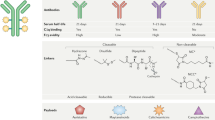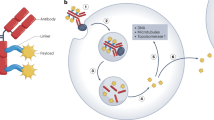Abstract
We describe the in vitro and in vivo properties of monoclonal antibody (mAb)-drug conjugates consisting of the potent synthetic dolastatin 10 analogs auristatin E (AE) and monomethylauristatin E (MMAE), linked to the chimeric mAbs cBR96 (specific to Lewis Y on carcinomas) and cAC10 (specific to CD30 on hematological malignancies). The linkers used for conjugate formation included an acid-labile hydrazone and protease-sensitive dipeptides, leading to uniformly substituted conjugates that efficiently released active drug in the lysosomes of antigen-positive (Ag+) tumor cells. The peptide-linked mAb-valine-citrulline-MMAE and mAb-phenylalanine-lysine-MMAE conjugates were much more stable in buffers and plasma than the conjugates of mAb and the hydrazone of 5-benzoylvaleric acid-AE ester (AEVB). As a result, the mAb-Val-Cit-MMAE conjugates exhibited greater in vitro specificity and lower in vivo toxicity than corresponding hydrazone conjugates. In vivo studies demonstrated that the peptide-linked conjugates induced regressions and cures of established tumor xenografts with therapeutic indices as high as 60-fold. These conjugates illustrate the importance of linker technology, drug potency and conjugation methodology in developing safe and efficacious mAb-drug conjugates for cancer therapy.
This is a preview of subscription content, access via your institution
Access options
Subscribe to this journal
Receive 12 print issues and online access
$209.00 per year
only $17.42 per issue
Buy this article
- Purchase on Springer Link
- Instant access to full article PDF
Prices may be subject to local taxes which are calculated during checkout





Similar content being viewed by others
References
Carter, P. Improving the efficacy of antibody-based cancer therapies. Nat. Rev. Cancer 1, 118–129 (2001).
Dillman, R.O. Monoclonal antibodies in the treatment of malignancy: basic concepts and recent developments. Cancer Invest. 19, 833–841 (2001).
King, K.M. & Younes, A. Rituximab: review and clinical applications focusing on non-Hodgkin's lymphoma. Expert Rev. Anticancer Ther. 1, 177–186 (2001).
Schwartzberg, L.S. Clinical experience with edrecolomab: a monoclonal antibody therapy for colorectal carcinoma. Crit. Rev. Oncol. Hematol. 40, 17–24 (2001).
Yarden, Y. & Sliwkowski, M.X. Untangling the ErbB signaling network. Nat. Rev. Mol. Biol. 2, 127–137 (2001).
Dubowchik, G.M. & Walker, M.A. Receptor-mediated and enzyme-dependent targeting of cytotoxic anticancer drugs. Pharmacol. Ther. 83, 67–123 (1999).
Bross, P.F. et al. Approval summary: gentuzamab ozogamicin in relapsed acute myeloid leukemia. Clin. Cancer Res. 7, 1490–1496 (2001).
Hamann, P.R. et al. An anti-CD33 antibody calicheamicin conjugate for treatment of acute myeloid leukemia. Choice of linker. Bioconjug. Chem. 13, 40–46 (2002).
Hamann, P.R. et al. Gemtuzamab ozogamicin, a potent and selective anti-CD33 antibody-calicheamicin conjugate for treatment of acute myeloid leukemia. Bioconjug. Chem. 13, 47–58 (2002).
Trail, P.A. et al. Cure of xenografted human carcinomas by BR96-doxorubicin immunoconjugates. Science 261, 212–215 (1993).
Saleh, M.N. et al. Phase I trial of anti-Lewis Y drug immunoconjugate BR96-doxorubicin in patients with Lewis Y-expressing epithelial tumors. J. Clin. Oncol. 18, 2282–2292 (2000).
Liu, C. et al. Eradication of large colon tumor xenografts by targeted delivery of maytansinoids. Proc. Natl. Acad. Sci. USA 93, 8618–8623 (1996).
Chari, R.V.J. et al. Enhancement of the selectivity and antitumor efficacy of a CC-1065 analogue through immunoconjugate formation. Cancer Res. 55, 4079–4084 (1995).
Ojima, I. et al. Tumor-specific novel taxoid monoclonal antibody conjugates. J. Med. Chem. 45, 5620–5623 (2002).
Jain, R.K. Physiological barriers to delivery of monoclonal antibodies and other macromolecules in tumors. Cancer Res. 50, 814–819 (1990).
Dubowchik, G.M. et al. Cathepsin B-labile dipeptide linkers for lysosomal release of doxorubicin from internalizing immunoconjugates: model studies of enzymatic drug release and antigen-specific in vitro anticancer activity. Bioconjug. Chem. 13, 855–869 (2002).
King, H.D. et al. Monoclonal antibody conjugates of doxorubicin prepared with branched peptide linkers: inhibition of aggregation by methoxytriethyleneglycol chains. J. Med. Chem. 45, 4336–4343 (2002).
Toki, B.E., Cerveny, C.G., Wahl, A.F. & Senter, P.D. Protease-mediated fragmentation of p-amidobenzyl ethers: a new strategy for the activation of anticancer prodrugs. J. Org. Chem. 67, 1866–1872 (2002).
de Groot, F.M., Damen, E.W. & Scheeren, H.W. Anticancer prodrugs for application in monotherapy: targeting hypoxia, tumor associated enzymes, and receptors. Curr. Med. Chem. 8, 1093–1122 (2001).
Trouet, A., Masquelier, M., Baurain, R. & Deprez-De Campeneere, D. A covalent linkage between daunorubicin and proteins that is stable in serum and reversible by lysosomal hydrolases, as required for a lysosomotropic drug-carrier conjugate: in vitro and in vivo studies. Proc. Natl. Acad. Sci. USA 79, 626–629 (1982).
Pettit, G.R. The dolastatins. Fortschr. Chem. Org. Naturst. 70, 1–79 (1997).
Vaishampayan, U. et al. Phase II study of dolastatin-10 in patients with hormone-refractory metastatic prostate adenocarcinoma Clin. Cancer Res. 6, 4205–4208 (2000).
Madden, T. et al. Novel marine-derived anticancer agents: a phase I clinical, pharmacological, and pharmacodynamic study of dolastatin 10 (NSC 376128) in patients with advanced solid tumors. Clin. Cancer Res. 6, 1293–1301 (2000).
Otani, M. et al. TZT-1027, an antimicrotubule agent, attacks tumor vasculature and induces tumor cell death. Jpn. J. Cancer Res. 91, 837–844 (2000).
Pettit, G.R. & Barkoczy, J. Tumor inhibiting tetrapeptide bearing modified phenethyl amides. US 5,635,483 (1997).
Carl, P.L., Chakravarty, P.K. & Katzenellenbogen, J.A. A novel connector linkage applicable in prodrug design. J. Med. Chem. 24, 479–480 (1982).
Koblinski, J.E., Ahram, M. & Sloane, B.F. Unraveling the role of proteases in cancer. Clin. Chim. Acta 291, 113–135 (2000).
Wahl, A.F. et al. The anti-CD30 monoclonal antibody SGN-30 promotes growth arrest and DNA fragmentation in vitro and affects antitumor activity in models of Hodgkin's disease. Cancer Res. 62, 3736–3742 (2002).
Satoh, T. & Hosokawa, M. The mammalian carboxylesterases: from molecules to functions. Annu. Rev. Pharmacol. Toxicol. 38, 257–288 (1998).
Schrappe, M. et al. Long-term growth suppression of human glioma xenografts by chemoimmunoconjugates of 4-desacetylvinblastine-3-carboxyhydrazide and monoclonal antibody 9.2.27. Cancer Res. 52, 3838–3844 (1992).
Wallace, P.M. & Senter, P.D. In vitro and in vivo activities of monoclonal antibody-alkaline phosphatase conjugates in combination with phenol mustard phosphate. Bioconjug. Chem. 2, 349–352 (1991).
Acknowledgements
This work was supported in part by Grant 1R43 CA 88583-01A1 from the National Cancer Institute. We acknowledge George Robert Pettit, Nathan Ihle and Perry Fell for useful discussions, and Nick Vincent-Maloney, Starr Rejniak and Jennifer Haugen for experimental assistance.
Author information
Authors and Affiliations
Corresponding author
Ethics declarations
Competing interests
The authors declare no competing financial interests.
Rights and permissions
About this article
Cite this article
Doronina, S., Toki, B., Torgov, M. et al. Development of potent monoclonal antibody auristatin conjugates for cancer therapy. Nat Biotechnol 21, 778–784 (2003). https://doi.org/10.1038/nbt832
Received:
Accepted:
Published:
Issue Date:
DOI: https://doi.org/10.1038/nbt832
This article is cited by
-
Progress in systemic therapy for advanced-stage urothelial carcinoma
Nature Reviews Clinical Oncology (2024)
-
Tissue factor (coagulation factor III): a potential double-edge molecule to be targeted and re-targeted toward cancer
Biomarker Research (2023)
-
The progress of novel strategies on immune-based therapy in relapsed or refractory diffuse large B-cell lymphoma
Experimental Hematology & Oncology (2023)
-
Novel biomolecules in targeted cancer therapy: a new approach towards precision medicine
Medical Oncology (2023)
-
Recent developments of automated flow chemistry in pharmaceutical compounds synthesis
Journal of Flow Chemistry (2023)



